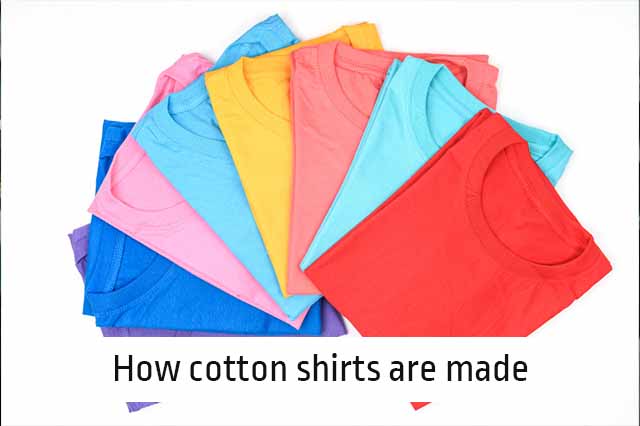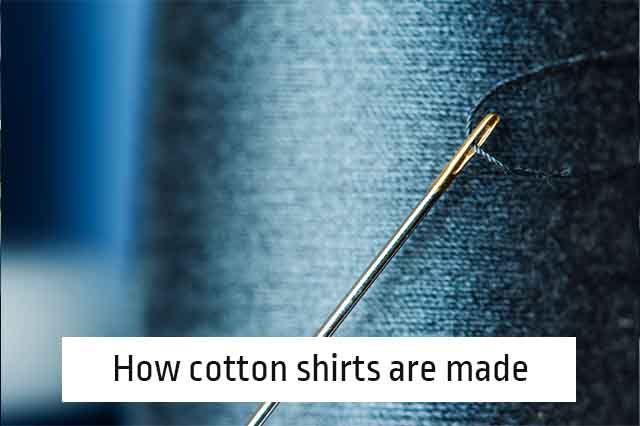Have you ever wondered how the comfortable, breathable cotton shirts you love to wear are made? From the spinning of the thread to the final stitching of the shirt, the process of making a cotton shirt is an intricate journey. In this article, we’ll explore the various stages of production that go into making a cotton shirt, from where the cotton is sourced to the finishing touches that make it ready to wear. So, buckle up and get ready to learn all about how cotton shirts are made!
Overview of cotton fabric and its properties
Cotton fabric is among the most popular fabrics in the world. It is known for its breathable, lightweight and comfortable properties, and its ability to be easily dyed and printed upon. It is often used to make clothing such as shirts, pants, skirts, and dresses.
Cotton shirts are typically made from a combination of cotton and polyester, although some may be made entirely of cotton. The first step of making a cotton shirt is to spin the cotton thread into a yarn, which is then woven into a fabric. Once the fabric is woven, it is examined for quality control, and then it is cut into the various pieces that make up the finished shirt. The pieces are then stitched together, and seams are finished for a neat and tidy look. The shirt is then inspected one last time and pressed before being packaged and ready to be shipped.
Making a cotton shirt requires skill and expertise, as well as attention to detail at every stage of the process. This is why high-quality cotton shirts are worth the investment—they are made with care and precision, and the result is a shirt that is comfortable, breathable, and made to last.
Growing and harvesting of cotton
Cotton is a versatile, natural fiber, and it has been used in clothing for centuries. Cultivation and harvesting of cotton is an important part of the production process for cotton shirts. To begin, cotton is grown in warm, tropical regions, such as India and Texas. Farmers grow the cotton plants, then harvest the fibers by picking the bolls from the plants. This process can be labor-intensive and requires specialized equipment, such as cotton pickers.
Once the cotton is harvested, it is sent to a spinning mill. Here, the fibers are converted into yarn and various thicknesses of thread are created. The yarn is then woven into fabric, and the fabric is cut into the desired shape for shirts. The fabric is then passed along to a sewing room, where it is stitched into a shirt. After stitching, the shirt is checked for any imperfections and then passed along to the finishing area, where it is pressed, folded, and packaged. The finished shirt is then ready to wear!
As you can see, the process of making a cotton shirt is a long and complicated journey that makes use of numerous resources, from the cotton growers to the finishers. It takes a lot of hard work and attention to detail to make sure every shirt is perfect, and it also takes an understanding of the different stages of production. With this knowledge, you can now appreciate the journey of a cotton shirt from start to finish!
Spinning and weaving of cotton into fabric
Have you ever wondered how the comfortable, breathable cotton shirts you love to wear are made? From the spinning of the thread to the final stitching of the shirt, the process of making a cotton shirt is an intricate journey. In this article, we’ll explore the various stages of production that go into making a cotton shirt, from where the cotton is sourced to the finishing touches that make it ready to wear. So, buckle up and get ready to learn all about how cotton shirts are made!
One of the earliest stages in the making of a cotton shirt is the spinning of the thread. This can be done either by hand or using a spinning machine. To create the thread, cotton fibers are twisted together to create a single, strong thread. This thread is then used to make the fabric that will eventually become the shirt.
Once the thread is spun, it is then woven into fabric. This can either be done by hand, using traditional techniques such as backstrap and frame weaving, or with modern machines. The fabric is woven on a loom, which consists of threads stretched across a frame. The weaving process is used to create intricate designs and patterns, or to create a plain fabric. Once the fabric is woven, it is then cut, sewn, and finished to create the shirt.
Finally, the shirt is ready to be worn. Buttons, labels, and other details are added, and the shirt is pressed and steamed to give it a crisp, finished look. The shirt is now ready to be shipped, allowing you to enjoy the comfort and breathability of a cotton shirt.
From the spinning of the thread all the way to the finishing touches, the process of making a cotton shirt is one that takes both time and skill. The result is a timeless piece of clothing that is sure to last for years to come.
Designing and cutting patterns for t-shirts
Designing and cutting patterns for t-shirts is a crucial step in the process of making a cotton shirt. It involves creating a design for the shirt, usually with a computer-aided design program, and then using a cutting machine to cut the pattern pieces from the fabric. The cutting machine can be either manually operated or automated, and the pattern pieces may be cut from a single piece of fabric or multiple pieces.
Once the pattern pieces are cut, they are then manually stitched together, often times using a sewing machine. The pattern pieces are then checked for accuracy, since even the slightest mistake can have a significant impact on the overall look of the finished product. The pattern pieces are then attached to the shirt’s body and the sleeves and neckline are added, along with any additional details such as pockets or collars. The last step is to add the final touches, such as buttons or zippers.
Designing and cutting patterns for t-shirts is a crucial step in the process of making a cotton shirt, and requires a great deal of skill and precision. It is an important part of the manufacturing process, and the quality of the finished product depends heavily on the accuracy of the pattern pieces. With careful attention to detail and an eye for quality, the process of creating a beautiful and comfortable cotton shirt can be achieved.
Sewing the fabric pieces into a t-shirt
Once the cotton is sourced from the farm, it is spun into yarn – the first step in the production of a shirt. The yarn is measured and wound into bobbins for specific areas of the shirt. These bobbins are then loaded into a circular knitting machine that creates a tubular shape from the yarn. Once the shape is set, the fabric pieces are cut and sewn into the shape of a shirt.
The cut pieces are then taken to a sewing machine for the next stage of production. Here, the pieces are sewn together to form the shape of a shirt. This process involves stitching around the neckline, armholes, and hem, as well as connecting the side seams and shoulders of the shirt. The shirt is then flipped right-side-out, and the sleeves and hems are folded, pressed, and stitched into place. Finally, any buttons, zippers, or other details are added to give the shirt a finished look.
Once the shirt is completed, it is inspected and quality-checked to ensure it meets the standards of the company. If the shirt is approved, it is packed into boxes and sent out for retail stores and customers to purchase. From beginning to end, the process of sewing a cotton shirt is a complex journey, but it is worth it when you have a beautiful, finished shirt ready to wear.
Adding a neckband and hemming sleeves and bottom
Adding a neckband and hemming the sleeves and bottom of a cotton shirt is an important part of the manufacturing process. A neckband is a piece of fabric that is stitched to the neckline of the shirt and secured in place with a series of stitches. This ensures that the neckline of the shirt has a neat finish and is comfortable to wear. After the neckband is added, the sleeves and bottom of the shirt are hemmed to ensure a clean finish. This is done by folding the fabric and stitching it in place, creating a smooth edge. The hemming process also helps to give the shirt its shape and keeps the fabric from fraying. Finally, the seams of the shirt are stitched together with a specialized machine, completing the process of making a cotton shirt.
The process of making a cotton shirt may seem daunting, but with the right tools and techniques, it’s a fairly straightforward task. With these steps, you can create a comfortable and stylish shirt that you can enjoy for years to come. Crafting a cotton shirt is a rewarding experience for anyone who likes to make their own clothes, and the end result is always worth the effort.
Decorating options such as screen printing, embroidery, and heat transfer vinyl
Before the production process for cotton shirts even begins, the type of fabric used must be determined. This means considering the type of cotton that best suits the project’s needs. Cotton is available in a variety of textures, from lightweight to heavy-weight, and each type can be used to create a certain look and feel. Once the fabric type is chosen, the next step is to transform the cotton into a shirt. This can be done through several different types of decoration options, such as screen printing, embroidery, and heat transfer vinyl.
Screen printing relies on a stencil to create the desired design on the garment. The stencil is covered with a special ink that penetrates the fabric and won’t easily fade or crack. Embroidery is a type of decorative stitching that can be used to create intricate designs on the shirt. The fabric is stitched with a special embroidery thread, which can be made from a variety of materials. Heat transfer vinyl is a type of adhesive vinyl that is applied to the shirt using a heat press. This method is often used to make complex designs, logos, and words that stand out.
Each of these decorating options has its own unique advantages and disadvantages, so it’s important to consider them carefully before deciding which is best for your project. With these three types of decoration, you can create a unique and stylish cotton shirt that will last for years to come.
Quality control and final inspection before shipping
One of the most important steps in the production of a cotton shirt is quality control and final inspection before shipping. Quality control ensures that all garments meet the same standard of excellence and craftsmanship. Quality control is conducted throughout the entire production process, from the selection of raw materials to the stitching of the finished product. The quality control process will involve a number of inspections and tests, including measuring finished garments to check for accuracy, examining the seams and stitching, and checking the fabric itself for signs of defects such as color fading, shrinkage, and weak spots.
Before the shirt is ready to be shipped, a final inspection is often conducted. This final inspection is to ensure that the shirt meets all of the desired specifications and quality standards. Any garments that do not meet the required standards are then set aside for repair or recycling. Once the final inspection is complete, the garment is packed and shipped to the customer. This final inspection helps to ensure that the customer receives only the highest quality product.
Quality control and final inspection are essential elements of the production process for any type of product, and especially for the production of cotton shirts. These steps help to guarantee that the finished product meets the highest standards of excellence and that the customer receives only the best possible product. Quality control and final inspection ensure that the customer receives only the best quality cotton shirt, and that they can enjoy it for years to come.
Environmental and ethical considerations in the cotton t-shirt industry
Cotton is one of the most widely-used fabrics in the world today, and it’s easy to see why. Cotton is comfortable, breathable, and can be dyed in a variety of colors. But have you ever wondered how the comfortable, breathable cotton shirts you love to wear are made?
The production of cotton shirts involves a range of environmental and ethical considerations. The cotton must be sustainably sourced and harvested, and the manufacturing process must follow safety regulations to protect workers. In addition, dyeing and finishing processes must be conducted in an environmentally responsible manner.
At every step of the production process, environmental and ethical considerations must be taken into account. Sustainable farming practices must be used to ensure that the cotton used is grown without depleting natural resources or harming the environment. Additionally, the dyeing and finishing processes must be conducted in a way that does not damage the environment. Finally, the health and safety of workers must be taken into consideration to ensure that they are not exposed to hazardous chemicals or working conditions.
Advances and innovations in cotton t-shirt production.
Cotton shirts are produced in multiple stages, beginning with sourcing the raw material. Cotton is harvested from the fields, then washed and combed before being sent to the spinning mill. Here, the cotton is spun into yarn strands which are then dyed to the desired color. The yarn is then sent to the weaving factory, where it is woven into cotton fabric.
Once the fabric is woven, it is ready to be cut and sewn. Automated machines are used to cut out the various pieces of the shirt, such as the body, sleeves, and collar. Then, the pieces are sewn together and pressed to ensure that the seams are flat and even. After the shirt is stitched, it is put through a series of tests to ensure quality and integrity. The shirt is then ready for the finishing touches, such as embroidery, embellishments, or printing.
Advances in technology have made the process of producing cotton shirts faster and more efficient. Automated machines have replaced many manual processes, and with advances in fabric dyeing, shirts are now available in a variety of colors and designs. The use of sustainability practices, such as the use of organic cotton, has also become popular in the production of cotton shirts, ensuring that the entire process is gentle on the environment.


